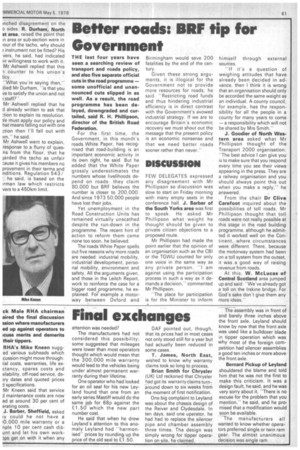Final exchanges
Page 63

If you've noticed an error in this article please click here to report it so we can fix it.
ck Male RHA chairman aired the final discussion ssion where manufacturers ed up against operators to ;cuss merits and demerits their tippers.
RHA's Mike Kneen sugged various subheads which cussion might move through tial costs, warranties, life exctancy, spares costs and ilability, off-road service, de.iry dates and quoted prices d specifications.
Mr Kneen said that service d maintenance costs are now ed at around 30 per cent of erating costs.
J. Barber, Sheffield, asked iy could he not have a i0,000 mile warranty or a nple 10 per cent cash disunt and let his own work3p5 get on with it when any attention was needed?
The manufacturers had not considered this possibility; some suggested that mileages were lower than most operators thought which would mean that the 300,000 mile warranty would lead to the vehicles being under almost permanent warranty during their lifetime.
One operator who had looked for an oil seal for his new Leyland found that one from an early series Mastiff would do the same job for 68p against the £1.50 which the new part number cost.
He said that when he drew Leyland's attention to this anomaly Leyland had "harmonised" prices by rounding up the price of the old seal to £1.50. DAF pointed out, though, that its prices had in most cases not only stood still for a year but had actually been reduced in some cases.
T. James, North East, wished to know why warranty claims took so long to process.
Brian Smith for Chrysler (UK) Ltd reckoned that Chrysler had got its warranty claims turnaround down to six weeks from the moment of first notification.
One big complaint to Leyland was about the chassis design of the Reiver and Clydesdale. In ten days, said one operator, he had had to replace the silencer pipe and chamber assembly three times. The design was simply wrong for tipper operation on site, he claimed, The assembly was in front of and barely three inches above the front axle. Leyland should know by now that the front axle was used like a bulldozer blade in tipper operation which was why most of the foreign competition had silencer assemblies a good ten inches or more above the front axle.
Bernard Pickup of Leyland shouldered the blame and told him that he was not the first to make this criticism. It was a design fault, he said, and he was very sorry about it. "There is no excuse for the problem that you mention," he said, and he promised that a modification would soon be available.
The manufacturers all wanted to know whether opera tors preferred single or twin ram gear. The almost unanimous decision was single ram.








































































































